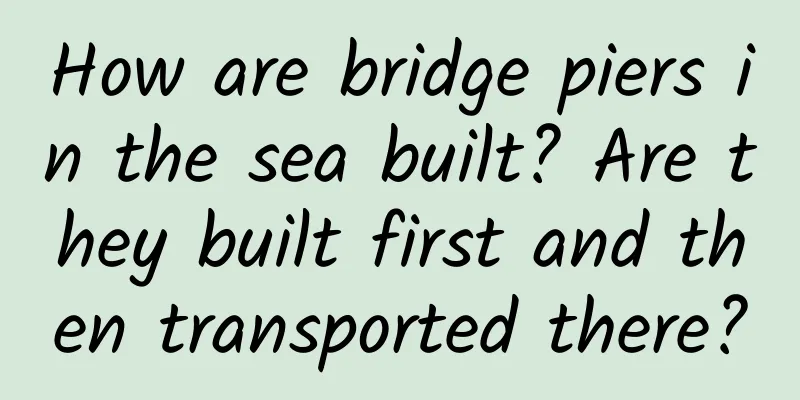How are bridge piers in the sea built? Are they built first and then transported there?

|
Bridges are an important part of modern transportation, but it is impossible for a bridge to float in the air. If a bridge wants to stand firm, it must have piers to support it. As for how the piers are built, most people know it pretty well. In the past few decades, my country's urbanization process has gradually accelerated, and bridges have sprung up. As long as you live in a city, you must have seen the construction of bridge piers. Simply put, the construction of a bridge pier can be divided into several steps. The first step is to dig a deep pit underground. The second step is to use concrete to cast a foundation, which is simply a cube made of concrete. The third step is to use steel bars to weave the skeleton of the pier on the foundation, and then splice the pier mold welded with high-quality steel plates to the pier skeleton. The last step is to use concrete to cast the skeleton made of steel bars and molds, so that a pier that looks solid is built. Building bridge piers on land does not seem to require much technical skills, but if you build them in water, the difficulty increases instantly. So far, humans have built numerous cross-sea bridges, and the piers supporting these bridges are all buried deep in the sea. Take the Hong Kong-Zhuhai-Macao Cross-Sea Bridge as an example. The average sea depth of the sea where the piers are located is 37 meters. There are many cross-sea bridges with an average sea depth of more than 80 meters. So how do humans build piers in such deep sea water? There is a rumor that the piers of cross-sea bridges are all built on land and then transported to the sea. Is this true? Not really. There are four main methods for building cross-sea bridge piers. None of them is built completely on land and then transported to the sea. If one of the four methods is closest to the rumor, it may be the "caisson" method. It is basically impossible to build a bridge pier made of reinforced concrete on the ground and then transport it to the sea, but if you just transport a "caisson", it can still be done. The so-called "caisson" is actually a hollow cube whose interior is composed of a grid-like structure. Because it is hollow, it is much easier to transport. After the caisson is built, it will be transported to the sea by barge and allowed to sink. However, the seabed is not a solid block, but a large amount of silt. As the caisson sinks, a machine is used to pump out the silt underneath, so that the caisson can finally land on the hard seabed rock layer. After that, it is only necessary to use concrete to pour the grid-shaped hollow caisson, and a bridge pier is built. This method can be said to be building the outer shell of a bridge pier on land first, and then completing the internal filling in the sea. The other three methods have little to do with land and are basically built entirely in the sea. One of the three methods of building bridge piers in the sea, originally called "cofferdam". It is easy to build bridge piers on land, so can we use the same method to build bridge piers in the sea? Of course, there is only one problem to solve, that is sea water. The so-called cofferdam is just like "playing with mud" when we were kids. It uses mud and steel plates to enclose an area in the sea, and then uses pumping equipment to pump out the seawater. In this way, a "waterless land" is enclosed in the sea. Then the construction can be carried out just like building bridge piers on land, except that the mud and steel plates cannot be completely sealed. Therefore, during the construction process, water must be continuously pumped to prevent the seawater from flooding the "enclosed land." The last two methods of building bridge piers are called "piling" and "drilling," and the two are related. We should be familiar with the term "piling" because it is a common method of building buildings on land. When we need to build a building in a place with wet and loose soil, we can drive, press or screw piles of different materials into the ground to serve as the foundation of the building. This method can also be applied to underwater construction. You only need to put the pile driver on the ship and transport it to the sea, then you can start piling on the sea surface. However, due to the impact of sea water in the sea, the piles must be driven at a certain degree of inclination to enhance their ability to withstand the impact of water flow. The last method is "drilling", which is actually a derivative method of pile driving. The geological conditions of the seabed are complex. In some places, the rocks are hard and piles cannot be driven in. Therefore, a sleeve must be inserted into the seabed first, and then a drill bit is used to drill holes in the sleeve. After that, steel bars are inserted, and finally concrete is poured. Then the foundation of a bridge is completed. Among the four methods of building bridge piers, the main construction part is completed in the sea, and the clumsy method of "building on land and then transporting to the sea" is not used. Moreover, such heavy bridge piers are difficult to transport. For more information, please follow the official account: sunmonarch |
<<: Does AI have consciousness? Let’s start with the definition of consciousness
>>: Patron? Protector? Friend? The relationship between the founding father and the sculptor
Recommend
Here is a Valentine's Day marketing promotion guide, please check it out!
Show affection and give gifts as they should (the...
GAC Group and Volcano Engine Signed a Strategic Cooperation Agreement
On August 2, GAC Group and Volcano Engine held a ...
How much does it cost to rent cloud space?
How much does it cost to rent cloud space? Cloud ...
Latest research: Elderly people who eat more meat may live longer! But pay attention to these 4 points
This article was reviewed by: Pa Lizhe, chief phy...
How to implement a lock screen widget for our App
One of the most requested features of iOS is a cu...
He shot a gorilla and brought it back to life
In 1896, in what is now Somalia, Carl Akeley fire...
February Marketing Node Reminder [Dry Goods Collection]
February 2020 is coming soon, and it is also a mo...
Using product thinking to understand why Ding Zhen became so popular?
In recent days, the Kangba man " Ding Zhen &...
Talk about 5 distribution mechanisms of video content
What position does content distribution occupy in...
How can a product attract users most effectively?
The essence of marketing is communication. If the...
Bailong Essay Douban In-depth Drainage Course, Drain 200+ Quasi-fine Powders per Day Worth 599 Yuan (Completed)
The course comes from Bailong Essays Douban’s in-...
How did the once-loved unicorns fall from grace?
From a former unicorn to being sold at a low pric...
Xigua Video Product Analysis Report
Watching videos in free time has become an entert...
What does Schrödinger's cherry blossom flavor taste like?
Science Times reporter epic Recently, many superm...
Android Pay: UnionPay's dream of near-field payment?
Mobile payment has penetrated into our daily life...









